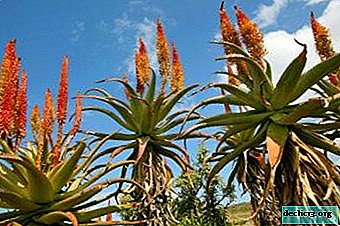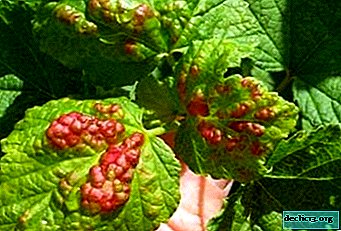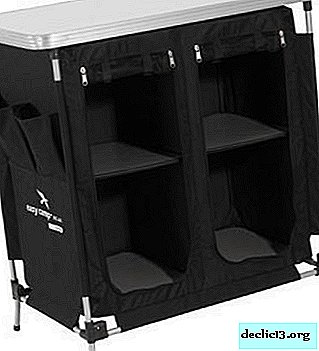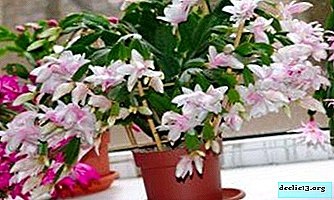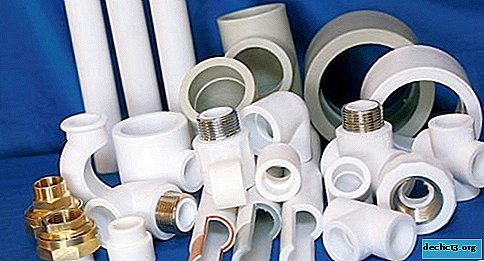The nuances of caring for primrose at home and outdoors - detailed instructions with photos
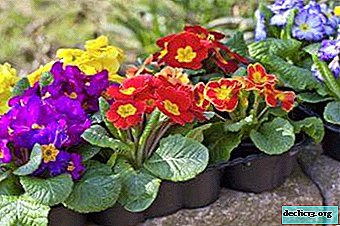
Primrose is a wonderful ornamental plant, a primrose, pleasing to the eye in early spring. Primrose is grown throughout our country: the plant, despite its southern origin, is unpretentious and easily tolerates cool temperatures.
Primrose is suitable for indoor breeding and garden cultivation. In the article we will get acquainted with the features of flower care, find out in what conditions primrose will grow best, find out the main points regarding watering, pruning, wintering of this plant.
Description
Reference! Primrose is a plant belonging to a large family of primroses. There are a lot of plant species - to date, scientists know about five hundred. In the wild, the flower can be found in South and North America, in the mountains of the Himalayas and the Alps, Asia.Note that this plant begins to delight with its beauty one of the first in the spring - literally, as soon as the snow falls.
 Among the varieties of this amazing flower, there are both annuals and perennials. And the variety of shades of its petals is simply amazing: almost all the colors of the rainbow are represented.
Among the varieties of this amazing flower, there are both annuals and perennials. And the variety of shades of its petals is simply amazing: almost all the colors of the rainbow are represented.
Inflorescences have an umbrella-like or brush-like shape, sometimes they are also single. For its beauty, decorativeness and, at the same time, unpretentiousness, primrose is appreciated by flower growers. We described primrose in more detail in this article.
Caring for this plant is uncomplicated - then we will tell you in detail about all the points.
Care Features
Consider how to care for the primrose of a room house in a pot and in the open air in the garden.
At home
Lighting, humidity and temperature
As for lighting, the primrose will feel good in the bright sun. Therefore, the southern windowsill will suit her perfectly. Note, however, that direct sunlight can burn the delicate petals of the plant, so the pot should be shaded in the afternoon.
In general, the plant will feel good on any window, however, it will show the greatest decorativeness and growth rate in a sunny place.
The air temperature in the room where primrose grows should not be too high. In winter, + 12-14 degrees is suitable for a flower, well, in summer, no more than + 16-20 degrees. In order to provide such a cool temperature that is not characteristic of our apartments, experienced gardeners recommend keeping primrose between the casement windows.
Since in the wild, the plant is always found near ponds and in moist soil, it must also provide appropriate conditions at home. It is necessary to water the flower regularly, avoiding, however, excessive waterlogging. The fact is that with an excess of moisture, the roots of primrose can rot - in this case, the entire plant will disappear.
The need for plentiful watering is also explained by the surface root system of the plant. Due to the fact that the roots are too close to the surface of the earth, they quickly dry out. It is not necessary to water the flower superficially: the primrose does not like it when drops of water fall on its leaves. Water directly under the root.
The plant rarely needs spraying in summer and winter. However, periodically the procedure must be carried out, irrigating the flower with water from a finely divided spray.
Attention: when the plant blooms, it should not be sprayed. Instead, place the pot on a pan with wet pebbles or expanded clay.The leaves of a houseplant are recommended to be cleaned of dust with a soft brush or panicle. Special polish in this case cannot be used. It will also be good for room primrose, if you begin to open the window or window in the room more often.
The plant in the fresh air feels great, grows faster, is less affected by diseases.
Soil, fertilizing, pot selection
 In order for the primrose to feel good and bloom beautifully, it needs loose and moist soil. You can either buy a finished substrate in the store, or make the desired mixture yourself.
In order for the primrose to feel good and bloom beautifully, it needs loose and moist soil. You can either buy a finished substrate in the store, or make the desired mixture yourself.
The composition of the soil should be sheet land and peat mixed with clean river sand. The last component should be approximately half smaller than each of the first.
They begin to feed the primrose from the moment the first leaflets appear - and continue to apply top dressing until they completely bloom.
Do not use a lot of nitrogenous fertilizers before primrose blooming, as this will lead to rapid growth of foliage, while flowering itself may not occur at all.
The nutrient solution for primrose should be weakly concentrated. If you buy ready-made complexes, then dilute them with water in a larger volume than indicated on the package.
In the garden
When to prune a bush?
This procedure is usually carried out in the spring. To primrose pleased with abundant flowering and good, good health, the plant must remove all weak, dead, dried stems, leaves.
Important: after transplanting, primrose usually pruned all the flowers in order to further achieve more abundant and lush flowering.After what time and how to share the outlet?
Primrose of perennial varieties is subjected to this procedure. When a plant is on the same bed for several years in a row, it grows rapidly over time. As a result, the flower sockets stick out, expose. In addition, in the garden gradually becomes less nutrients, the plant begins to develop worse, its decorativeness becomes lower.
Thus, regularly sharing outlets is a necessity in this case. Some gardeners, with particular zeal for their favorite business, divide and transplant primrose annually. But in general, for normal growth, development and flowering, it is enough to perform the procedure once every 3-4 years.
To properly separate the rosettes and transplant the plants, it is necessary to water the bush liberally, then dig it out, clear the roots from the ground, and divide it into 2-3 parts.
In each of the parts there should be a piece of root with at least one bud of renewed growth. Otherwise, the dividend does not rise. The division of outlets is carried out in early spring.
Garden soil, watering and top dressing
 Garden primrose will feel best of all on the north-western or western side of the garden: here it will be provided with optimal lighting, and at the same time, coolness. In the best way, the plant will develop and bloom in the shade of sprawling trees.
Garden primrose will feel best of all on the north-western or western side of the garden: here it will be provided with optimal lighting, and at the same time, coolness. In the best way, the plant will develop and bloom in the shade of sprawling trees.
Too much heat and direct rays of the sun can even lead to the death of the plant.
As for the soil, it should be loose and moderately nutritious. It is also important to free the bed from weeds in time.
It is necessary to water primrose in the garden quite often, but without flooding. In hot weather, double the frequency and volume of irrigation. After the humidification procedure, it is necessary to loosen the soil in order to ensure optimal conditions for the plant.
Feeding a garden primrose should begin from the moment the first leaves form, and end when the plants bloom. Use mineral complexes for top dressing - but in weaker concentration than indicated on the package. The frequency of fertilizer application is twice a month.
Autumn Care
After flowering, only primrose perennials are looked after. It is clear that after the flower has dropped its petals, there is no sense in caring for the annual.
It is recommended that the primrose watering be slightly increased by autumn so that the plant can form better and larger seeds. At the end of July, the primrose starts to grow, so at this time it must be fed with potash fertilizers and phosphorus.
Reference! This procedure will provide for the next growing season, abundant growth of bushes, the ripening of many new flower buds.If you are interested in learning about the care and transplant of a plant in the fall, we suggest reading this article.
Preparing for the winter
In autumn, it is necessary to carefully water those outlets that are divided and transplanted. Watering should be daily before wintering, but not too plentiful.
The outlet is not cut off before the cold - in winter it will perform the function of protecting the rhizome from freezing. To provide the plant with more comfortable conditions for wintering, It is recommended to sprinkle the bush on the root circle with humus: for fertilizer and protection against frost.
Note that some types of primrose need a more thorough and thoughtful preparation for the winter. Bushes of delicate varieties even cover before the cold from above with fallen leaves and agrofibre. Hybrid primrose are especially delicate - it is recommended to transfer them in boxes for the winter, and take them to a storage room. You can find out all the details about how to make preparations for the winter in another article.
Wintering Features
In order for the plant to overwinter safely, it must be at a temperature not lower than +14 degrees. And some varieties (hybrid) can tolerate temperatures not lower than +16 degrees.
Watering in winter should be infrequent: it is recommended to carry out the procedure only when the upper substrate is significantly dry. Frequency - about once a week.
Growing and Seating Procedure
Seeding primrose needs about once a year, often less often. It is recommended to transplant when the plants become lush, and are too tight in a pot or in a garden.
The best time for planting is early spring or autumn. As for the soil, the mixture should be standard: turf, sheet land, sand. If the flower grows in a pot, take care in advance of good drainage (at least 2 cm).
Important: Seeding is recommended only after the primrose has faded. In order not to disturb the natural processes of its vegetation.You will find all the rules for planting and growing primrose here.
Photo
In the photo below, you can familiarize yourself with the process of caring for primrose room:





Pests and diseases
The plant is susceptible to various diseases, which most often appear due to improper care. Next, we find out what diseases and pests affects the primrose in most cases.
Among the diseases, the following can be distinguished:
- anthracosis;
- powdery mildew;
- jaundice;
- cucumber mosaic;
- spotted wilting.
Among pests, the following insect species are especially often affected by primrose:
- nematode (both leaf and gall);
- weevil;
- spider mite;
- aphid.
Spider mites and aphids affect a flower in dry and hot weather. To cope with these dangerous insects, spray primrose with appropriate insecticides.
Spotting of fungal nature is most dangerous for primrose. This disease usually affects the plant in the spring, and you can recognize it by the appearance of pale round spots that appear on the leaves.
If left untreated, the disease can completely destroy the entire plant. And if the primrose grows on a bed surrounded by its own kind, then the mushroom can spread to neighboring flowers.
To cope with the spotting, the affected leaves are removed (or in case of severe damage, the whole plant). After this, the entire bed should be sprayed with a solution of topsin or foundationazole.
A disease like gray rot also often affects the flower. It usually occurs due to excessive watering. To eliminate dangerous rot, reduce the amount of moisture and spray the flower with a suitable fungicide.
If the flower begins to turn yellow, or the buds fall, the reason is most likely due to improper care. Usually this happens due to too dry air in the room or when the temperature is too high.
As already mentioned, primrose prefers a cool climate. In order to cope with the emerging problems, the pot should be taken out to a cool place, as well as a good watering of the flower.
Important: if the flowers begin to fade too quickly, literally, not having time to bloom properly, the reason is the high temperature. Primrose needs a cooler place for flowering.Useful video
Watch a video about primrose and care for this flower:
Conclusion
We learned how to take care of primrose growing both in the garden and at home on the windowsill. As you can see, the plant is not too whimsical, so it won’t cause much trouble. But it will cause a lot of pleasant emotions and joy with its wonderful decorative flowering.


